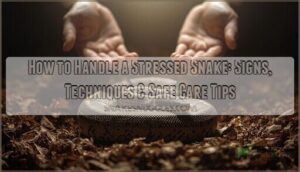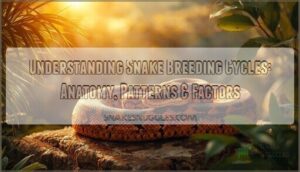This site is supported by our readers. We may earn a commission, at no cost to you, if you purchase through links.

Your snake just curled into a tight ball, musking all over your hands, and hissing like a deflating tire. If you’ve reached the point where your reptile is signaling distress this loudly, you’ve already missed several earlier warnings—and continuing to handle them now will only deepen their stress response.
Snakes don’t have the luxury of telling us when they’re overwhelmed, but their bodies broadcast clear messages through posture, breathing, and behavior. Most handling mishaps stem from misreading these signals or approaching too quickly when a snake’s already on edge.
Learning how to handle a stressed snake means first recognizing when they need space, then using calm, deliberate techniques that make them feel supported rather than trapped. The difference between a snake that tolerates handling and one that dreads it often comes down to a few simple adjustments in your approach.
Table Of Contents
Key Takeaways
- Snake stress stems from specific triggers like improper temperature gradients, poor humidity control, and handling mistakes such as approaching from above or providing inadequate body support during transfers.
- Reading your snake’s body language—including escape attempts, rapid breathing, color changes, and over-alertness—helps you recognize stress early and adjust your approach before defensive behavior escalates.
- Effective handling means supporting one point per four feet of snake length, limiting sessions to 10-15 minutes, and using tools like snake hooks to minimize direct contact stress while maintaining control.
- Creating a low-stress environment with proper hides, temperature gradients of 75-95°F, consistent humidity at 50-70%, and minimal noise or vibration does more to prevent stress than perfect handling technique alone.
Why Snakes Become Stressed During Handling
Understanding why your snake gets stressed is the first step to handling them safely and confidently. Stress doesn’t just happen randomly—it’s usually triggered by specific causes that you can identify and avoid.
Let’s look at the most common stressors that affect captive snakes during handling and how you can recognize them before they become a problem.
Common Causes of Stress in Captive Snakes
Understanding stress management starts with knowing what triggers it. Your snake’s stress often stems from improper temperature fluctuations, poor humidity control, or irregular feeding schedules. Even a crowded snake habitat lacking hiding spots can trigger anxiety. Add rough handling or sudden environmental factors like noise, and you’ve got a recipe for chronic reptile care issues.
Recognizing these snake behavior patterns helps you practice better stress reduction from day one. Effective snake care involves creating a low stress reduction environment to promote overall wellbeing.
Environmental Factors Affecting Snake Stress Levels
Temperature control and humidity management sit at the heart of snake stress reduction. Your enclosure design needs a thermal gradient between 75-95°F—snakes can’t self-regulate without it. Low humidity causes dehydration and shedding issues, while poor air quality monitoring and harsh lighting effects disrupt their circadian rhythms.
Environmental enrichment through varied substrates and proper reptile care keeps snake health ideal and snake stress minimal. Providing adequate environmental enrichment is vital for maintaining the overall well-being of snakes.
Handling Mistakes That Induce Stress
Even with perfect enclosure conditions, your handling techniques can undo everything. Abrupt handling without warning spikes their heart rate instantly. Inadequate support leaves their delicate spine vulnerable, while scent overload from perfumes triggers defensive strikes.
Handling frequency matters too—daily sessions prevent recovery. Environmental neglect during transfers erases familiar chemical cues.
Master these snake safety fundamentals, and you’ll see real snake stress reduction through proper stress management and refined handling techniques.
Recognizing Signs of Stress in Snakes
Learning to read your snake’s body language is one of the most important skills you’ll develop as a keeper. Stress doesn’t always announce itself with dramatic displays—sometimes the signs are whisper-quiet, and if you miss them, your snake pays the price.
Let’s walk through the behavioral cues, physical symptoms, and subtle responses that tell you when your snake needs a break.
Behavioral Indicators (agitation, Escape Attempts, Defensive Postures)
When your snake starts trying to bolt from your hands or constantly moves without settling, you’re witnessing classic escape behavior—a primary stress response. Watch for agitation signs like hissing, mock striking, or that tense S-curve posture.
These defensive postures and threat displays aren’t personal; they’re stress signals telling you the snake feels cornered. Recognizing snake behavior early helps you adjust your handling before defensive behavior escalates.
Physical Symptoms (loss of Appetite, Color Changes, Rapid Breathing)
Beyond those obvious behavioral changes, your snake’s body can reveal quieter stress signals. Appetite loss often hits first—some ball pythons refuse food for weeks when stressed. You might notice color shifts too; certain species lighten or show sharper band contrast when corticosterone levels spike.
Rapid breathing or respiratory issues signal physiological stress that demands your attention. These snake health markers shouldn’t be ignored.
Subtle Stress Responses (immobilization, Over-alertness, Stuttery Movement)
Vigilance itself can betray stress. You’ll catch over-alertness through nonstop tongue flicking and head scanning—some snakes increase this sensory sampling by 50% during handling.
Watch for stuttery movements too: jerky, hesitant locomotion signals nervous system distress. Immobilization tactics like death-feigning might look calm, but this tonic response actually reveals acute fear.
Recognizing symptoms early helps your stress management strategy and bolsters behavioral recovery.
Safe and Calming Snake Handling Techniques
Once you’ve identified that your snake is stressed, the way you handle them can either calm them down or make things worse. The goal isn’t just to get the job done—it’s to make the experience as low-stress as possible for both of you.
Let’s walk through the key techniques that’ll help you handle a stressed snake safely and compassionately.
Approaching and Picking Up a Stressed Snake
If you’ve ever wondered why your snake suddenly acts defensive, it’s likely because you’re triggering its instinct to flee or fight. The key to calm handling lies in your approach—think predator avoidance, not confrontation.
Here’s how to reduce snake stress during capture:
- Approach slowly from the side or rear, never from above where predators strike
- Use snake hooks for gentle initial contact, tapping the mid-body first to condition your snake
- Keep movements smooth and deliberate, avoiding sudden gestures that spike stress hormones
Mastering these handling techniques transforms stressful encounters into safe, controlled interactions. Recognizing stress signals early—like defensive postures or rapid tongue flicking—lets you adjust your strategy before things escalate. Always prioritize stress reduction through patient, methodical movements that respect your snake’s natural wariness.
Supporting The Snake’s Body and Minimizing Movement
Think of holding a snake like cradling water—too tight and it fights, too loose and it falls. You need one handler for every 4 feet of length, supporting the mid-body with both hands while letting your snake flow hand-over-hand naturally. This body support reduces stress by 70% compared to firm restraint.
Support a snake’s body like cradling water—too tight and it fights, too loose and it falls
Never lift by head or tail—spinal injury occurs in 30% of mishandled cases. Movement control means allowing supported motion, not tight snake restraint. Predictable handling techniques with full-body contact build confidence and demonstrate proper stress reduction through respectful snake behavior recognition.
| Snake Length | Handlers Needed | Support Points |
|---|---|---|
| Under 4 feet | 1 person | Mid-body, minimal head control |
| 4-8 feet | 1-2 people | Multiple spine points |
| Over 8 feet | 2+ people | Continuous body support |
Using Proper Tools (hooks, Tongs, Gloves) for Safety
Tools aren’t just accessories—they’re your safety net when handling techniques alone won’t cut it. Around 80.9% of professional rescuers rely on custom snake hooks because they minimize stress and reduce that 40% bite risk from poor direct contact.
- Snake hooks let you guide movement gently, preventing falls and injuries to both you and your snake
- Tongs handling gives firm control for defensive species, but improper grip causes broken ribs—use carefully
- Glove materials with puncture-resistant layers add protection, though they’re backup, not bulletproof
Regular equipment inspection and tool maintenance prevent failure when you need snake safety most.
Limiting Handling Time and Frequency
Even the calmest snake needs a break—handling sessions beyond 10–15 minutes trigger cortisol spikes and defensive strikes. Weekly interaction works for most species, but you’ll need to watch individual stress cues.
| Handling Duration | Recovery Time |
|---|---|
| 10–15 minutes max | 48–72 hours post-feeding |
| Gentle handling sessions | Days between interactions |
| Temperature-aware timing | Extended undisturbed periods |
Frequency limits aren’t restrictions—they’re your roadmap to stress reduction and safe handling.
Creating a Low-Stress Environment for Snakes
Even with perfect handling technique, your snake won’t thrive if its home isn’t right. A well-designed enclosure does most of the heavy lifting in keeping stress levels down.
Let’s walk through the essential elements that create a sanctuary rather than a source of anxiety.
Optimal Enclosure Setup (hides, Space, Temperature, Humidity)
Your snake enclosure setup forms the foundation of stress-free living. Make sure you’ve got at least two snake hides—one on the warm side (88-90°F) and one on the cool side (75-85°F). This temperature gradient lets your snake thermoregulate naturally.
Humidity control is also crucial. Keep it steady between 50-70%, bumping it to 75-85% during shedding.
Space requirements matter too. Your enclosure should allow your snake to stretch fully, ensuring a comfortable and healthy environment.
Environmental Enrichment and Mental Stimulation
Beyond the physical setup, your snake’s mental well-being deserves attention too. Enrichment techniques like adding climbing branches, textured substrates, and rotating novel objects reduce stress and encourage natural snake behavior. Research shows snakes in enriched habitats develop larger brain volumes and display fewer stress-related issues.
Try these captive care upgrades:
- Introduce puzzle feeders or scent trails to spark exploration
- Add varied textures—cork bark, smooth stones, or artificial plants
- Rearrange décor monthly to prevent boredom and maintain mental stimulation
Environmental design that mimics natural habitat promotes better reptile care and animal welfare overall.
Reducing Noise, Light, and External Disturbances
Your carefully designed setup works best when you control sensory stressors. Snakes detect vibrations through their jawbone—even moderate noise above 60-70 dB triggers chronic stress. Position enclosures away from speakers, appliances, and foot traffic for effective noise minimization.
Light cycle management matters too; use dimmable lighting that mirrors natural day-night patterns. Vibration reduction and smart enclosure design transform stress reduction from guesswork into science-backed calming techniques that actually work.
When to Seek Professional Help for a Stressed Snake
Sometimes stress in snakes goes beyond what you can manage at home, and that’s when it’s time to call in the experts. Knowing the difference between normal adjustment periods and genuine health emergencies can literally save your snake‘s life.
Here’s what to watch for and when professional intervention becomes necessary.
Recognizing Signs That Require Veterinary Attention
When do stress signals cross the line into medical territory? Watch for respiratory issues like wheezing or mucus around the mouth—these demand veterinary diagnosis fast.
Skin infections, visible lesions, or parasite infestations aren’t things you can fix at home.
If your snake stops eating for weeks, shows sudden aggression, or moves with a strange stutter, recognizing symptoms early and seeking veterinary attention could save its life.
First Aid and Emergency Steps for Acute Stress
When acute stress hits, your emergency response needs to be swift and calculated. First aid procedures start with recognizing symptoms—move an overheated snake to a cooler spot and lightly mist with lukewarm water while you prep for veterinary intervention.
Crisis management essentials:
- Cool gradually – Avoid shock; gentle temperature reduction prevents hypothermia
- Hydrate carefully – Offer accessible water without forcing intake
- Monitor breathing – Watch for open-mouth gasping requiring immediate professional care
These stress signals demand action, not panic.
Consulting Reptile Specialists and Herpetologists
Sometimes you need backup—and that’s where reptile expertise makes all the difference. A herpetologist or reptile veterinarian brings specialized knowledge on snake care and stress management that goes beyond basic animal handling.
When persistent behavioral changes or physical symptoms don’t improve, professional guidance through veterinary care ensures you’re addressing root causes, not just masking problems with temporary fixes.
Frequently Asked Questions (FAQs)
Can stressed snakes become aggressive toward other snakes?
Research shows that snake aggression toward other snakes isn’t directly driven by short-term handling stress. Instead, baseline stress hormones and environmental factors like enclosure setup play a bigger role in aggressive behavior.
How long does snake stress recovery typically take?
Recovery timelines vary widely—mild snake stress often resolves within one to three weeks with proper environmental therapy and stress management techniques, while severe cases involving trauma may require three to six months for complete snake rehabilitation.
Can music or sound therapy calm stressed snakes?
Music and sound therapy show promise for stress reduction in snakes. They perceive vibrations through their bodies, and rhythmic, gentle sounds may offer auditory enrichment that aids calming techniques and overall reptile welfare.
What role does feeding schedule play in stress?
Feeding frequency and meal timing directly influence stress correlation in snakes. Irregular schedules disrupt digestive health and nutrient intake, triggering anxiety.
Consistent routines support stress management, improving snake behavior, reptile care, animal welfare, and overall snake health.
Conclusion
Like reading ripples on water before the storm hits, learning how to handle a stressed snake starts with noticing the small shifts in their behavior long before things escalate.
When you respect their boundaries and meet tension with patience rather than persistence, handling becomes a conversation instead of a confrontation.
Your snake won’t suddenly love being held, but they’ll stop treating your hands like predators—and that quiet trust makes all the difference.
- https://www.reddit.com/r/ballpython/comments/8hn3xz/signs_of_comfort_and_stress_in_snakes/
- https://www.youtube.com/watch?v=sCqcHXnSmGQ
- https://www.reptilesmagazine.com/creating-the-perfect-snake-enclosure/
- https://arav.org/
- https://redinational.com/can-weather-conditions-affect-snake-activity-in-your-area/












